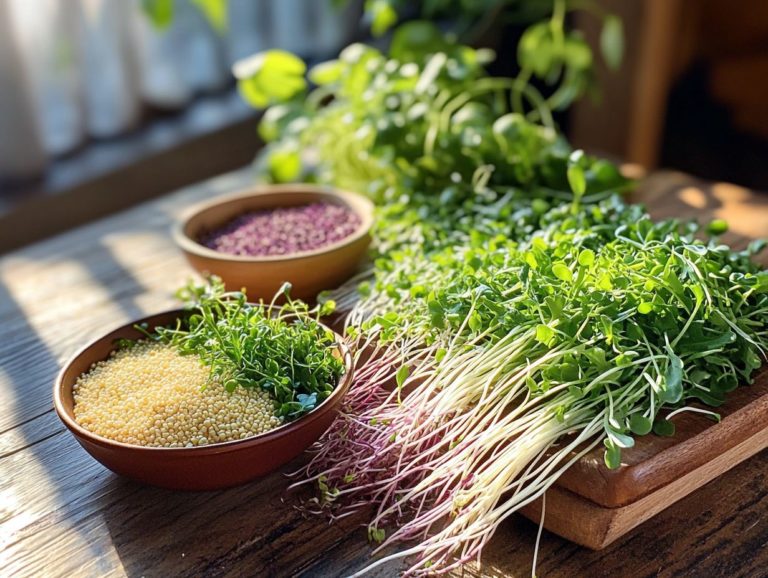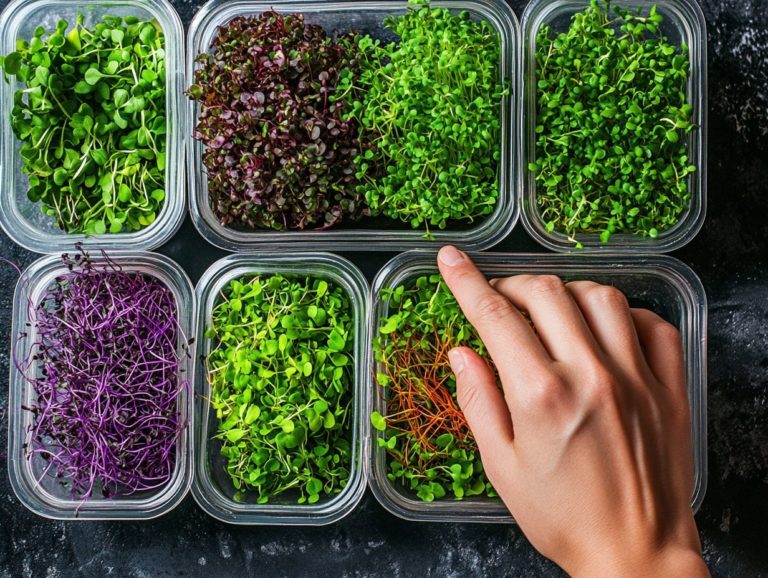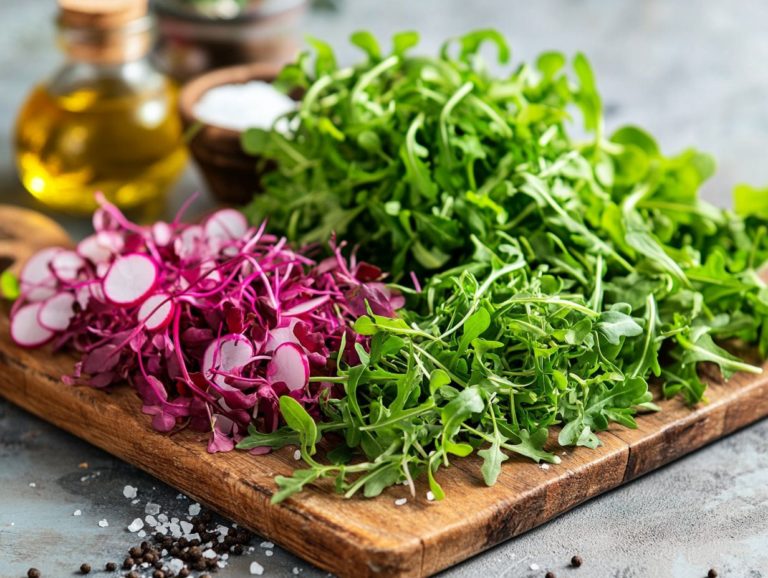5 Microgreens to Boost Your Metabolism
Microgreens are more than just trendy embellishments for your salads; they re nutritional powerhouses that can supercharge your metabolism.
These tiny greens are brimming with vitamins, minerals, and antioxidants. Each variety presents its own distinct flavor and health benefits. This article delves into the world of microgreens, examining how they enhance metabolic function and showcasing specific types such as broccoli, radish, and sunflower microgreens.
You ll also find invaluable tips on incorporating them into your diet and insights on how to cultivate your own. Don t miss out on the incredible benefits of adding these tiny greens to your meals!
Contents
- Key Takeaways:
- 1. What Are Microgreens?
- 2. How Do Microgreens Boost Metabolism?
- 3. Broccoli Microgreens
- 4. Radish Microgreens
- 5. Cilantro Microgreens
- 6. Mustard Microgreens
- 7. Arugula Microgreens
- 8. Pea Shoot Microgreens
- 9. Sunflower Microgreens
- 10. Wheatgrass Microgreens
- 11. How to Incorporate Microgreens into Your Diet
- 12. Other Benefits of Microgreens
- 13. Potential Risks and Precautions
- 14. How to Grow Your Own Microgreens
- Frequently Asked Questions
- What are microgreens and how can they boost my metabolism?
- Which 5 microgreens are known for their metabolism-boosting properties?
- How do these microgreens help boost metabolism?
- Can I just add these microgreens to my diet or do I need to consume them in a specific way?
- What are the benefits of consuming these 5 microgreens?
- What precautions should you take when consuming microgreens?
Key Takeaways:

- Incorporate microgreens into your diet to boost metabolism and improve overall health.
- Broccoli, radish, cilantro, mustard, and arugula microgreens are rich in nutrients that aid in metabolism.
- Consider growing your own sunflower, pea shoot, or wheatgrass microgreens for a cost-effective and convenient way to enjoy their benefits.
1. What Are Microgreens?
Microgreens are young vegetables that you can harvest just after their first true leaves develop. They offer a delightful burst of flavor while being packed with essential nutrients, vitamins, and minerals crucial for a healthy diet.
These tiny greens belong to the Brassicaceae family and boast impressive antioxidant properties. They not only elevate your culinary creations but also provide remarkable health benefits, such as cancer prevention and improved insulin management.
Common varieties include broccoli, radish, beet, and arugula. All of these thrive under conditions that provide adequate light, moisture, and warmth. These little powerhouses are not just visually appealing; they’re incredibly nutritious too, delivering a concentrated punch of vitamins A, C, E, and K, along with essential minerals like calcium, magnesium, and iron.
Their nutrient-dense profile makes them a fantastic addition to salads, sandwiches, and smoothies, enhancing both flavor and nutritional value in countless culinary applications. Many are even discovering the joy of using them as garnishes. Their distinct flavors can elevate any dish, making healthy eating not just easy, but truly enjoyable.
2. How Do Microgreens Boost Metabolism?
Microgreens have the remarkable ability to elevate your metabolism thanks to their dense concentration of nutrients and potent plant compounds that may enhance insulin sensitivity and mitigate inflammation within your body.
These petite powerhouses, such as broccoli, kale, and radish sprouts, are brimming with essential vitamins, minerals, and antioxidants. They support a variety of metabolic processes. Broccoli microgreens boast sulforaphane, a compound known for its ability to improve blood sugar regulation. Kale microgreens are abundant in glucosinolates, offering anti-inflammatory benefits that can bolster your metabolic health. For a delicious and nutritious addition to your diet, consider exploring 5 nutritious microgreen varieties for smoothies.
The unique phytochemicals found in these diminutive greens aid in managing insulin levels and contribute to your overall wellness by combatting oxidative stress. By incorporating these nutrient-dense greens into your daily meals, such as the top 5 microgreen varieties for breakfast, you can take proactive steps toward enhancing your metabolic function.
3. Broccoli Microgreens
Broccoli microgreens are a true nutritional powerhouse. They are celebrated for their exceptionally high levels of vitamins C, K, and A, along with beneficial plant compounds that support heart health and may aid in cancer prevention.
These tiny greens have an impressive concentration of sulforaphane, a compound renowned for its potent antioxidant properties. It helps neutralize harmful free radicals in your body. Their remarkable nutrient profile not only reduces inflammation but also supports healthy cholesterol levels, contributing to your overall cardiovascular wellness.
The antioxidants found in broccoli microgreens play a pivotal role in lowering the risk of certain cancers by preventing cellular damage. Incorporating them into your diet is effortless; simply toss them into salads or smoothies, and enjoy the myriad health benefits they offer.
Start adding microgreens to your meals today for a vibrant, healthier lifestyle!
4. Radish Microgreens
Radish microgreens are a great addition to meals, renowned for their peppery flavor and impressive array of vitamins and minerals.
Adding them to your salads and sandwiches not only enhances taste but also brings strong antioxidant properties that can help reduce inflammation.
These vibrant greens also offer an exciting kick that can transform a variety of dishes. Imagine the zesty crunch they lend to tacos, grain bowls, or even as a sophisticated garnish for your soups.
Their nutritional profile is remarkable, boasting high levels of vitamin C, vitamins A and K, along with essential minerals like potassium and magnesium all contributing to your overall well-being.
Beyond the delightful flavor and nutritional advantages, radish microgreens are champions in combating oxidative stress, potentially easing symptoms associated with inflammatory conditions. Don t miss out on these nutritious greens!
By incorporating these greens into your daily meals, you can effortlessly elevate your culinary creations while supporting better health.
5. Cilantro Microgreens
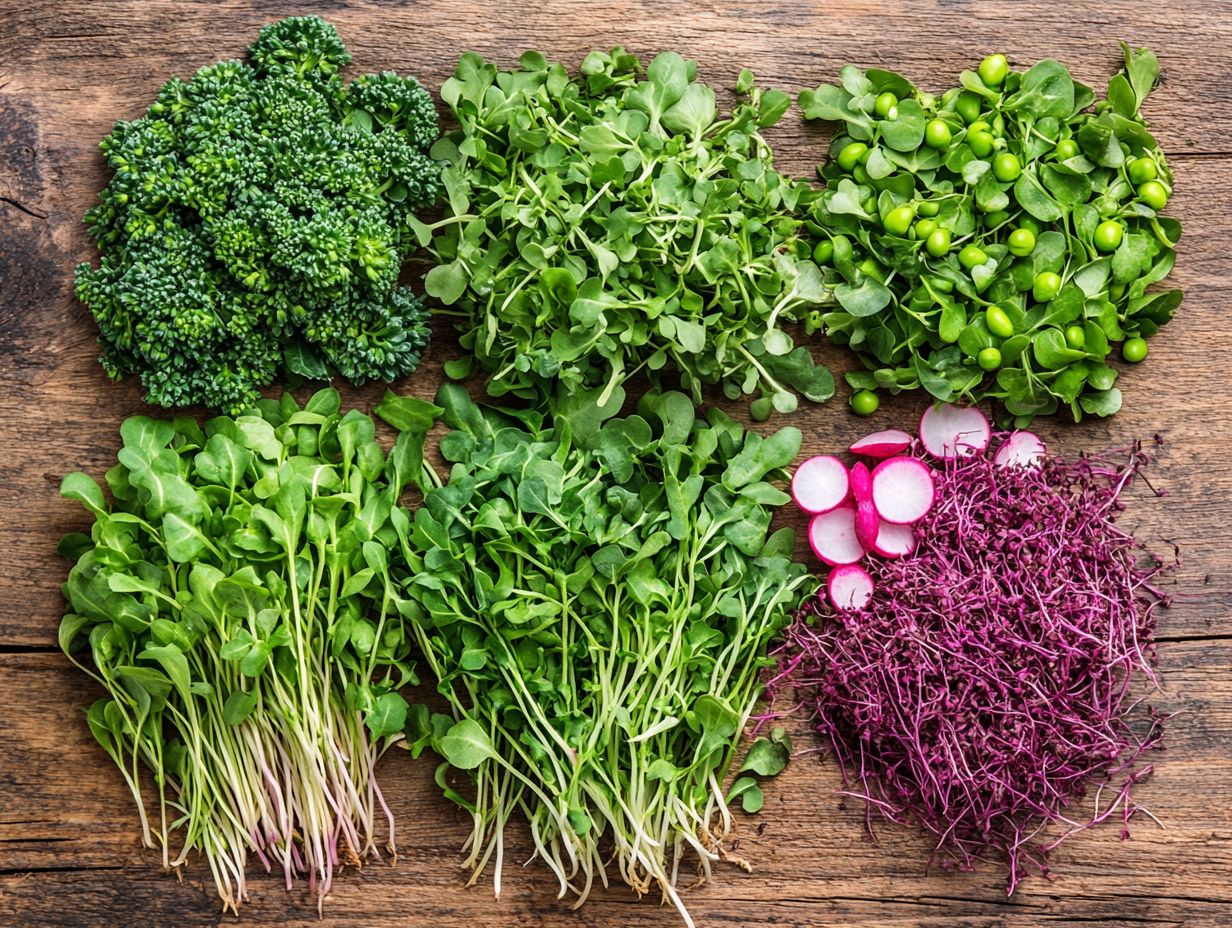
Cilantro microgreens bring a vibrant burst of flavor and are brimming with nutrients like vitamins A and K. They make the perfect garnish for a wide array of dishes while also delivering essential health benefits.
These delicate greens do more than just enhance the presentation of your salads, soups, and tacos; they also enrich your nutrient intake, supporting your overall well-being.
With their impressive antioxidant content, cilantro microgreens work to combat oxidative stress in your body, promoting healthier skin and reducing the risk of chronic diseases.
Their anti-inflammatory properties can aid digestion and strengthen your immune system, making them a savvy addition to your smoothies or sandwiches. Try adding them to your meals today!
By incorporating cilantro microgreens into your daily meals, you can savor enhanced flavors while reaping a multitude of health advantages.
6. Mustard Microgreens
Mustard microgreens, with their unmistakably spicy flavor, are more than just a culinary delight; they re a treasure trove of essential vitamins and minerals.
Boasting potent antioxidant properties, they may aid in cancer prevention. These vibrant greens, flaunting a vivid green hue and a delicate, tender texture, elevate countless dishes with their uniquely peppery taste.
Rich in nutrients such as vitamins A, C, E, and K, along with a variety of B vitamins, they contribute significantly to your overall wellness.
They also contain vital compounds like glucosinolates, which are compounds found in some plants that may help fight cancer. By regularly incorporating mustard microgreens into your meals, you not only enhance flavor but also potentially bolster your body s defenses against oxidative stress and inflammation critical factors in cancer development.
7. Arugula Microgreens
Arugula microgreens are celebrated for their peppery flavor and remarkable nutrient density, including vitamins K and A. These vitamins provide robust antioxidant properties that enhance their appeal in any health-conscious diet.
These tiny greens pack a delicious punch, making them a go-to choice for salads, sandwiches, and gourmet dishes alike. Their distinct, tangy profile can transform a simple meal into a culinary delight.
Rich in essential minerals like calcium and iron, arugula microgreens play a vital role in promoting bone health and facilitating oxygen transport in the blood.
Their versatility in the kitchen allows you to use them as a garnish or blend them into smoothies for an added nutritional boost.
With their unique flavor and impressive health benefits, incorporating these microgreens into your daily meals offers a delicious avenue for enhancing your overall well-being.
8. Pea Shoot Microgreens
Pea shoot microgreens are a delightful addition to your culinary repertoire. They are tender, sweet, and bursting with nutrients.
They serve as a rich source of vitamins and minerals, offering potential benefits that may aid in the prevention of heart disease.
These vibrant greens are brimming with vitamins A, C, and K, along with a wealth of antioxidants that contribute to your overall health.
Incorporating pea shoot microgreens into your diet can enhance digestion and bolster your immune system.
Their versatility allows them to elevate various meals. Imagine enhancing your salads with their crisp texture, adding a refreshing flavor to your sandwiches, or even blending them into smoothies for an extra nutritional boost.
With their ability to brighten up any dish, pea shoot microgreens are not just a nutritious choice; they re an appealing ingredient that transforms your meals into something truly special.
9. Sunflower Microgreens
Sunflower microgreens are a vivid and nutritious addition to your diet, brimming with essential vitamins and minerals. They re particularly noteworthy for their substantial vitamin E content, which bestows impressive antioxidant properties.
These young seedlings don t just bring a pop of flavor to your dishes; they also serve as a powerhouse of nutrients that can bolster your overall health.
Whether tossed into salads, layered in sandwiches, or blended into smoothies, they provide a delightful crunch and a subtle nutty taste that can elevate your meals.
Their high levels of antioxidants work tirelessly to combat oxidative stress in your body, helping to fend off chronic diseases and promote longevity.
By incorporating sunflower microgreens into your diet, you’ll effortlessly enhance both your nutritional intake and your culinary creativity, especially when exploring unique microgreen varieties for exotic flavors.
10. Wheatgrass Microgreens
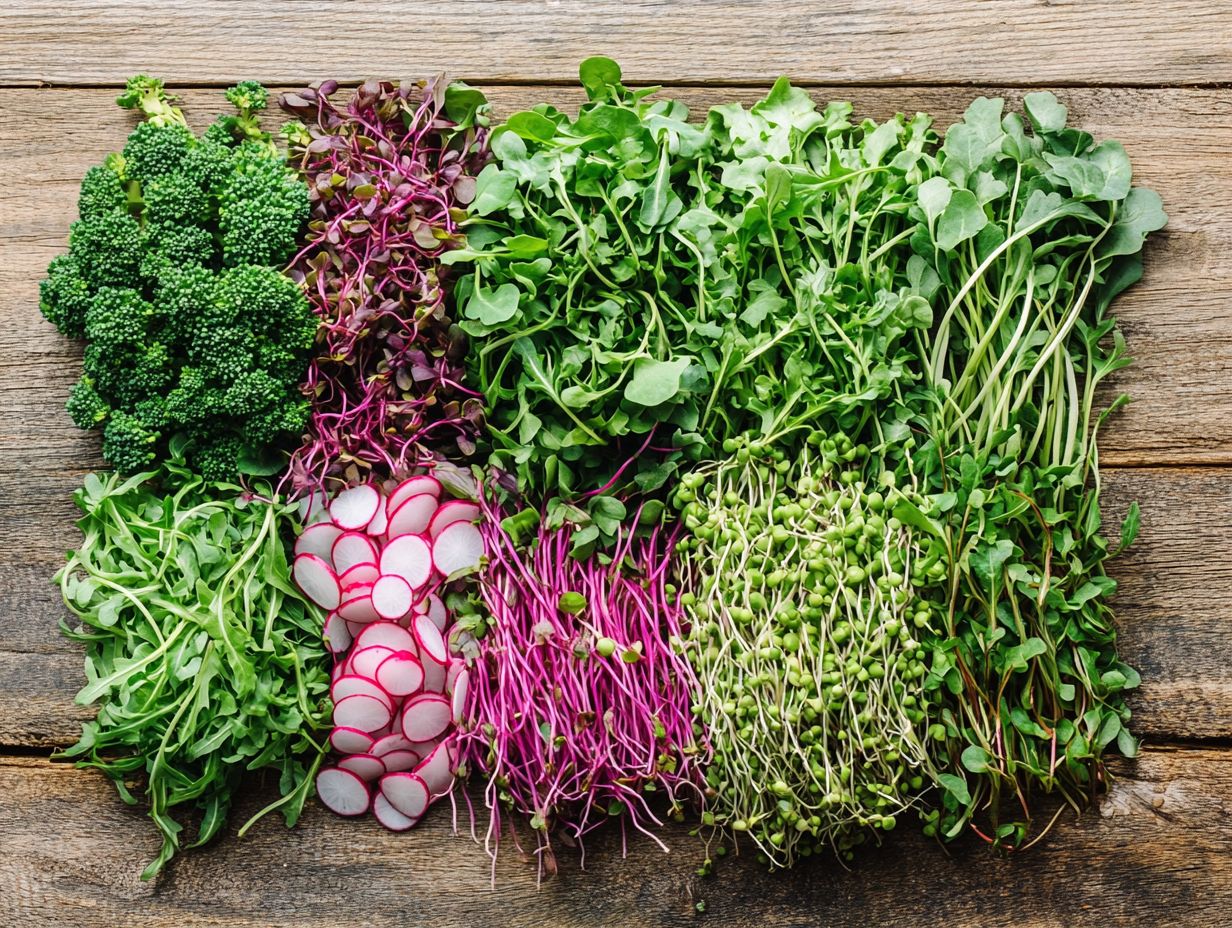
Wheatgrass microgreens are your go-to for nutrient density, brimming with vitamins and minerals that enhance overall health, including reducing inflammation and supporting heart health.
Their vibrant green hue and robust flavor make these tiny powerhouses truly remarkable.
Packed with essential nutrients like vitamins A, C, and E, along with a variety of B vitamins, they re great for your health.
Plus, they serve as an excellent source of chlorophyll, which boasts antioxidative properties that may help combat oxidative stress.
Incorporating wheatgrass microgreens into your diet regularly can help lower markers of inflammation, contributing to better cardiovascular health.
By promoting healthy circulation and potentially lowering cholesterol levels, they play an essential role in heart wellness.
Whether tossed in salads, blended into smoothies, or used as a garnish, these microgreens are a fantastic addition to elevate your meals.
11. How to Incorporate Microgreens into Your Diet
Adding microgreens to your meals is easy and incredibly rewarding! You ll love the burst of flavor and health benefits they bring.
Packed with an impressive array of vitamins, minerals, and antioxidants, microgreens are a great addition to your cooking options.
Tossing them into salads adds not just a bright pop of color but also a delightful crunch.
If you blend a handful into your smoothies, you can elevate the nutritional profile without overwhelming the taste.
For a touch of gourmet flair, sprinkle microgreens as a garnish on soups or entrees; they provide visual appeal and a burst of flavor that can elevate any dish.
Their versatility means these greens can seamlessly fit into your breakfast, snacks, or even sandwiches, making regular consumption an effortless yet nutritious choice.
Don’t miss out on the chance to boost your meals and health with these amazing microgreens!
12. Other Benefits of Microgreens
Microgreens offer you a treasure trove of health benefits that extend far beyond their vibrant flavor. Think about their impressive anti-inflammatory properties, potential cancer-fighting capabilities, and support for your eye health all thanks to their high nutrient content.
These tiny greens are bursting with vitamins, minerals, and antioxidants that can significantly elevate your overall well-being. For example, broccoli microgreens are loaded with a compound found in broccoli that may help reduce cancer risk. Red cabbage microgreens are a powerhouse of vitamin C, boosting your immune function and skin health. Additionally, spinach microgreens are rich in lutein and zeaxanthin, key players in maintaining healthy vision. For an extra boost in your smoothies, consider the top 5 microgreens for smoothies.
Incorporating these nutrient-rich young plants into your diet is an effortless way to enhance your nutritional benefits and overall health, particularly for those concerned about iron deficiency.
13. Potential Risks and Precautions
While microgreens are generally safe and packed with nutrition, it’s important to consider potential risks. These may include iron deficiency in certain populations and the threat of contamination from improper growing conditions.
For those with specific dietary needs or health conditions, indulging in these young plants might unintentionally worsen existing nutritional imbalances. If grown in contaminated soil or with unfiltered water, these delicate greens could harbor harmful bacteria like E. coli or Salmonella.
To keep yourself safe, follow these simple best practices:
- Use clean, organic soil
- Sanitize tools
- Thoroughly wash the greens before consumption
Taking these precautions can significantly diminish health risks while enabling you to savor the flavors and nutrients that microgreens add to your meals.
14. How to Grow Your Own Microgreens
Growing your own microgreens is not just a project; it s an exciting journey that brings fresh greens to your plate, elevating your healthy diet with nutrient-packed options right from your own home garden.
By immersing yourself in this simple yet satisfying activity, you can cultivate a variety of microgreens, such as radish, basil, and sunflower. Each of these brings unique flavors and health benefits to your plate. These tiny powerhouses are celebrated for their concentrated nutrient profiles, often boasting higher levels of vitamins, minerals, and antioxidants than their mature counterparts. For those looking to enhance their diet further, exploring microgreen varieties that boost your immune system can be particularly beneficial.
To embark on this delightful venture, gather some basic supplies like seeds, trays, and a suitable growing medium. With minimal space and effort, you can transform a sunny windowsill into a vibrant microgreen haven, making healthy eating not just convenient, but also incredibly gratifying.
Frequently Asked Questions

What are microgreens and how can they boost my metabolism?
Microgreens are young vegetable plants that are harvested after the first few leaves have sprouted. They are packed with nutrients and have a high concentration of antioxidants and polyphenols, which can help boost your metabolism and improve overall health.
Which 5 microgreens are known for their metabolism-boosting properties?
The five microgreens known for boosting metabolism are broccoli microgreens, kale microgreens, watercress microgreens, radish microgreens, and red cabbage microgreens. These microgreens are rich in nutrients and antioxidants that can help increase your metabolism.
How do these microgreens help boost metabolism?
Microgreens contain high amounts of vitamins, minerals, and enzymes essential for metabolic functions in the body. They also have a low glycemic index, which measures how foods affect blood sugar, meaning they do not cause a spike in blood sugar levels, helping the body maintain a steady metabolism.
Can I just add these microgreens to my diet or do I need to consume them in a specific way?
You can include these microgreens in your diet in various ways. Add them to salads, sandwiches, smoothies, or use them as a garnish for your dishes. You can also consume them raw, as cooking may reduce some of their nutritional value.
What are the benefits of consuming these 5 microgreens?
These microgreens do more than just boost metabolism. They improve digestion, strengthen your immune system, and help reduce inflammation.
They’re also rich in fiber, which supports weight loss and overall gut health. Enjoying them can be a delicious way to enhance your diet!
What precautions should you take when consuming microgreens?
Microgreens are usually safe, but it s important to wash them thoroughly to remove any contaminants.
If you have allergies or health conditions, check with your doctor before adding them to your meals.

